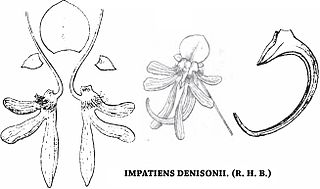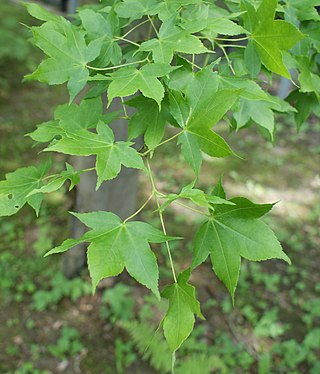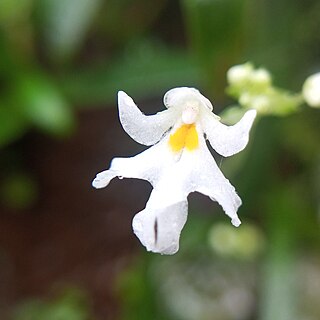
Pachypodium ambongense is a species of plant in the family Apocynaceae. It was first published as a species of the genus Pachypodium in 1924 by the botanist Henri Louis Poisson.

Lobelia scaevolifolia is a species of the plant family Campanulaceae. It is endemic to the island of Saint Helena in the South Atlantic Ocean. It was at one time placed as the only species, Trimeris scaevolifolia, in the genus Trimeris. Its common name is St. Helena lobelia.

Malva alcea is a plant in the mallow family native to southwestern, central and eastern Europe and southwestern Asia, from Spain north to southern Sweden and east to Russia and Turkey.

Epidendrum anceps, literally the "two-edged upon a tree," a species of epiphytic orchid in the genus Epidendrum, is sometimes known as the brown epidendrum or dingy-flowered epidendrum.

Epidendrum blepharistes is a species of orchid in the genus Epidendrum native to Bolivia, Colombia, Costa Rica, Ecuador, Peru, and Venezuela.

Cestrum diurnum is a species of Cestrum, native to the West Indies. Common names include day-blooming cestrum, day-blooming jessamine, and day-blooming jasmine. Also known as Din ka Raja, in Urdu and Hindi. The scent of this quick-growing and evergreen woody shrub, often used for screens and borders, is released by day. Cestrum diurnum is easily propagated from the seed, which it produces in abundance.

Impatiens denisonii is a scapigerous herb species of the family Balsaminaceae, which is found only in the Western Ghats in South India. It is among the rarest of the eighteen Impatiens species which are endemic to the Nilgiri Hills. It was very abundant and considered among the most beautiful plants in the Nilgiri Hills.

Brunfelsia latifolia, commonly known as yesterday-today-tomorrow and kiss me quick, is a species of flowering plant in the nightshade family. Endemic to Brazil, it is an evergreen shrub that becomes semi-deciduous in cooler areas and grows up to 1.8 meters in height.

Acer oliverianum, common names Oliver's maple and Oliver maple, is broadleaf deciduous tree. It is a species of maple.

Karomia speciosa is an African deciduous large shrub or bushy tree up to 7 m, and relocated to the family Lamiaceae from Verbenaceae. It is one of 9 species in the genus Karomia, a genus containing species previously classified in Holmskioldia, and is closely related to Clerodendrum. The only remaining species in the genus is Holmskioldia sanguinea, occurring in the foothills of the Himalayas.

Acer kawakamii is an Asian species of maple, found only in Taiwan. The species is sometimes confused with another Taiwanese tree, Acer morrisonense. This species has been known to reach 20 metres tall. Leaves are non-compound, the blade narrowly ovate, up to 11 cm long by 4.5 cm wide, with serrate margins but no lobes.

Bhesa indica is a flowering plant tree species in the Centroplacaceae family. It is distributed along the tropical wet evergreen forests of the Western Ghats of India. It is considered synonymous with Bhesa paniculata by some authors.
Pachystoma nutans, is a species of plant in the orchid family. It is endemic to Myanmar. It was first described by Sing Chi Chen and Yi Bo Luo in 2002. The type specimen of Pachystoma nutans was previously overlooked among unidentified Eulophia species at the Royal Botanic Garden herbarium in Edinburgh. It is only known from the type specimen, which was collected near Mong Yaw, Myanmar.

Prunus himalayana, called jyokun shin in Tibetan and 喜马拉雅臭樱 in Chinese, is a species of Prunus native to Nepal, Bhutan, Sikkim and Tibet. It prefers to grow 2,800 to 4,200 m above sea level in the Himalayas. As Maddenia himalaica it was the type species for the now unrecognized genus Maddenia.

Acer distylum, the lime-leaved maple or linden leaved maple, is a species of flowering plant in the family Sapindaceae, native to north Honshu Island of Japan. Its closest relative is Acer nipponicum, with which it is grouped in the Acer section Parviflora. The species is noted for its 10–15 cm (4–6 in) unlobed leaves, the like of which are not found in any other maple species. The bark is grayish, and has a pink cast in young specimens. Acer distylum was first described by Philipp Franz von Siebold and Joseph Gerhard Zuccarini in 1845, and later brought to Europe by Charles Maries in 1879.

Digitalis nervosa is a species of flowering plant in family Plantaginaceae. It is native to the Caucasus down to north western and northern Iran.

Mertensia sibirica, commonly known as Japanese bluebells or Siberian bluebells, is a species of flowering plant belonging to the family Boraginaceae. Originally discovered by Carolus Linnaeus, who named it Pulmonaria sibirica, this plant is found, as its name implies, in Eastern Siberia and northern China. After review of the plant's morphology, its taxonomic position was changed to Mertensia sibirica by botanist and plant collector George Don, who put forth the notion of the change, which was eventually accepted, most likely due to the striking resemblance to the related species in the Americas like Mertensia virginica, or Virginia bluebells.

Impatiens henslowiana is a flowering plant of the Balsaminaceae family, native to the Indian states of Kerala and Tamil Nadu, as well Sri Lanka. It is a large shrub that grows either terrestrially or epiphytically.

Impatiens scapiflora is a species of flowering plant in the family Balsaminaceae. Impatiens scapiflora or Leafless-Stem Balsam is a terrestrial or epiphytic or lithophytic herb endemic to Western Ghats.

Impatiens stocksii is a species of flowering plant in the family Balsaminaceae. It is endemic to the Western Ghats.























